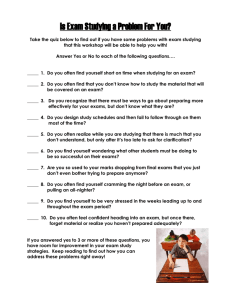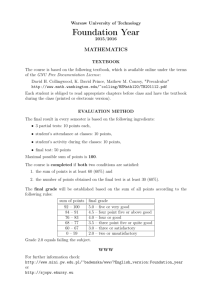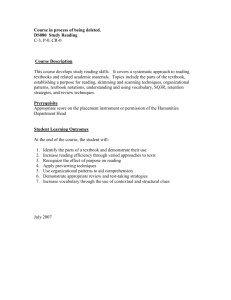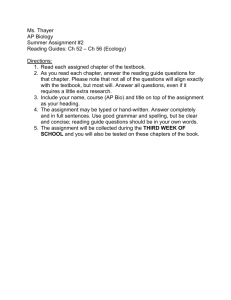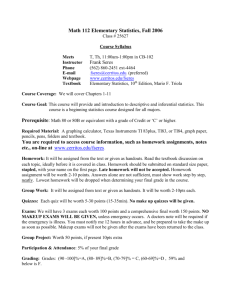Now
advertisement
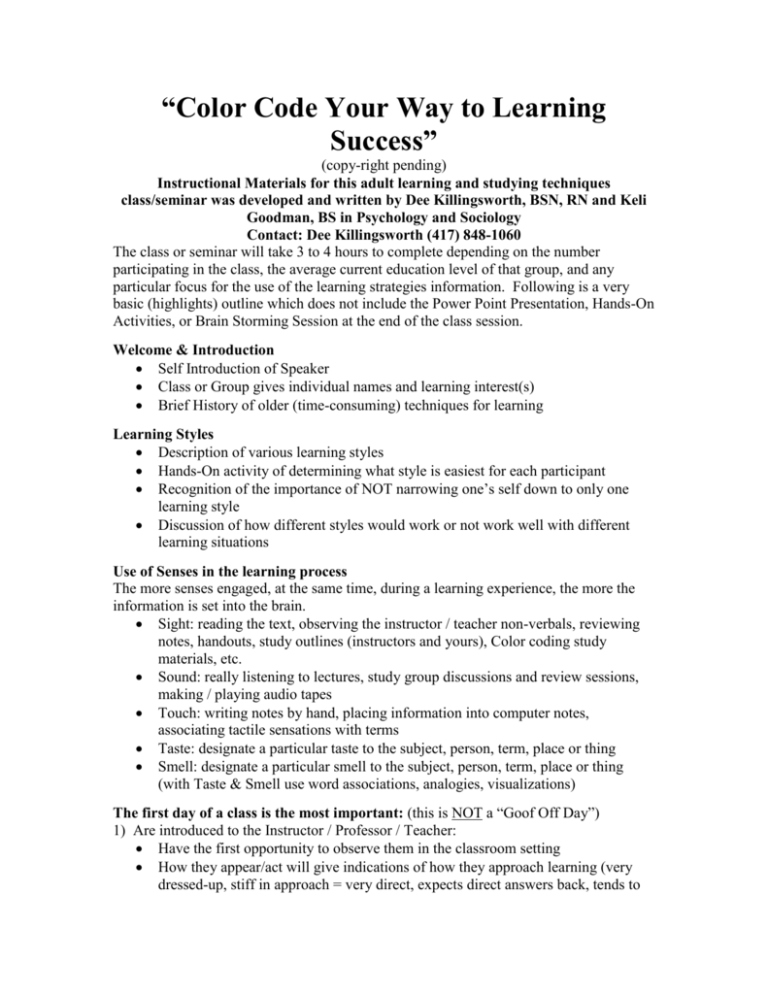
“Color Code Your Way to Learning Success” (copy-right pending) Instructional Materials for this adult learning and studying techniques class/seminar was developed and written by Dee Killingsworth, BSN, RN and Keli Goodman, BS in Psychology and Sociology Contact: Dee Killingsworth (417) 848-1060 The class or seminar will take 3 to 4 hours to complete depending on the number participating in the class, the average current education level of that group, and any particular focus for the use of the learning strategies information. Following is a very basic (highlights) outline which does not include the Power Point Presentation, Hands-On Activities, or Brain Storming Session at the end of the class session. Welcome & Introduction Self Introduction of Speaker Class or Group gives individual names and learning interest(s) Brief History of older (time-consuming) techniques for learning Learning Styles Description of various learning styles Hands-On activity of determining what style is easiest for each participant Recognition of the importance of NOT narrowing one’s self down to only one learning style Discussion of how different styles would work or not work well with different learning situations Use of Senses in the learning process The more senses engaged, at the same time, during a learning experience, the more the information is set into the brain. Sight: reading the text, observing the instructor / teacher non-verbals, reviewing notes, handouts, study outlines (instructors and yours), Color coding study materials, etc. Sound: really listening to lectures, study group discussions and review sessions, making / playing audio tapes Touch: writing notes by hand, placing information into computer notes, associating tactile sensations with terms Taste: designate a particular taste to the subject, person, term, place or thing Smell: designate a particular smell to the subject, person, term, place or thing (with Taste & Smell use word associations, analogies, visualizations) The first day of a class is the most important: (this is NOT a “Goof Off Day”) 1) Are introduced to the Instructor / Professor / Teacher: Have the first opportunity to observe them in the classroom setting How they appear/act will give indications of how they approach learning (very dressed-up, stiff in approach = very direct, expects direct answers back, tends to be rigid in expectations of students; very casual = more open, looks at topics/subjects from more than one angle, are generally more flexible, etc.) Listen to them very closely – in their overview of the class, will get a very good indication of where their focus for the class lies (will help with direction to take in organizing study materials.) 2) Are given an Outline or Syllabus for the class: THIS IS A VERY IMPORTANT TOOL – USE IT WISELY Place the assignment dates, test/exam dates, project/papers due dates on your calendar in RED… (or place all of this information in an EXCEL or Database Sheet with rows and columns for each and highlight the due dates.) Now, move the assignment dates up 1 to 3 days and the project / papers / presentation due dates up at least 1, preferably 2 weeks in advance and place these, highlighted new dates in bright blue, yellow or lime green on your calendar or in your computer datasheet. These are your NEW Personal due dates… In moving the due dates up it helps you to not procrastinate, helps you focus on organizing the information to be studied, and allows time for polishing projects/papers/presentations to bring them to a higher level of excellence and quality (which will also boost grades!!!), but most of all helps you get rid of the anxiety and worry related to feeling like you are constantly under pressure or not having enough time to accomplish the requirements and goals of the class. (Your mindset for tests/exams should be to start preparing for them as soon as you begin an assignment. Will be discussing “Organization” tips to use from day one to accomplish this.) Do NOT look at the Syllabus/Outline/Textbook as a whole… it will be too overwhelming (you will want to reduce stress as you tackle each of the components which will help keep you on target and give a sense of control over the material to be covered as well as give smaller, more frequent, degrees of accomplishment throughout the whole process which will add up nicely.) That first Assignment: Use bookmarks to show the beginning pages and ending pages of the assigned unit to be covered. (This will keep the assignment in perspective and give a visual “ending” to it.) Read down through the first few pages and look for the writer’s organization of the textbook. Do they 1) start off with the most important statement of the paragraph in the first sentence and then give supporting information afterward, 2) give a lead-in sentence, the important statement, followed by the explanation or 3) give all of the background and supporting information first and then end with the most important statement? Learning the textbook writer’s organization patterns will help you zero in on what the writer (and instructor / teacher) feels is the most important information that needs to be learned and remembered. (Activity: have examples of each and have participants determine which example is of what kind.) Organize the information derived from the textbook and place into your own (complete) study guide which will include textbook information, lecture information, class handouts, etc. (Directions on how to do this will be given throughout this presentation as each type of material to be learned is discussed.) If your textbook is going to be yours to keep and you are not planning sell back the textbook after completion of the class, you can use highlighters in the book. If you are only using the book or plan to sell the book back, DO NOT mark or use highlighters in the book, but DO photocopy the assigned portion so that you can highlight and mark the copy for information organization and studying purposes. 2 (Hands-On, Small Group activity – to show how to do on their own later) Organize the information within the textbook using certain colors for specific information. Highlight in Yellow for important concepts, Pink for important people, Blue for terms & definitions, and Green for information with numbers, etc. (At the same time, place post- it-notes at the edge of the page, in the same colors, marked with the topic, name, term, etc.) This process brings the information down to nugget sized bites and formats information so it is very easy to retrieve and place in your personally organized study guide. Taking Notes during Lectures As with the textbook authors, learn how your instructor organizes their lectures which will help you determine what they consider the most important information to be and you need to take notes on. DO NOT take down every word… you will get behind and miss out on other important information. Learn to take notes listing only important words and phrases. DO NOT use complete sentences. Use bullets, lists, etc. under a specific heading, which will make it easier to incorporate the lecture notes into your organized study guide along with information from your text, instructor’s study guide, hand-outs, etc. If you have an audio recorder, ask permission to audio tape the class lecture. Use this tape only once to review closely and pull out the important information. Add this to your written class notes. Add the information to your personally organized study guide. (described below) As with the textbook, go through the lecture note information and color code by highlighting the specific information and placing labeled colored markers at the edge of the page. (Example will be shown.) This will make sorting and organizing the information a very fast and easy process. (Analogy will be given of “as with computer file, sub-file organization which makes drilling down an easier process, we are going to organize the information to learn and memorize into a format that we will be able to focus and drill down to the information which will make it easier to pull the information back out of our brains. Organizing information and Developing your own Study Guide Start the process of organizing unit information at the very beginning of the unit and continually add to it until all of the assigned text info, lecture info, hand-outs and any other important information is incorporated. (DO NOT WAIT to organize the information till just before the test or exam. By doing this as you go through the unit, it takes less time to organize smaller portions and places it in a format that can be reviewed and studied from the start of the unit, which will make preparing for tests or exams less time consuming and stressful.) There are two different ways to approach organizing the information to be learned. (Use whichever one is easiest for you.) 1) Start at the beginning of the text and pull a certain term, person or concept and place all information related to that into a notes page or computer program page, beginning a new page for each. Continue through the assigned text material until all are identified. Then, go through the lecture notes and 3 place the information from those on the corresponding study guide page. Continue this process with any other learning material and teacher prepared study guides obtained during the class. 2) Start with a term, person, concept, and pull all information together from text, lecture, etc. using as many pages as needed and then start with a new page for a different term, person, concept, etc. With either of these methods, place a code at the end of each information entry to be able to identify the source of the information. (T) for text, (L) for lecture, (HO) for Hand-Out, (SG) for Study Guide, etc. Now, organize the information within each color coded section either chronologically or from the most important to the least important. (This is much easier done on a computer because you can cut and paste the info allowing you to move it around on a page. Or, if you prefer to do it by hand, you can actually “cut” out information with scissors and “paste” with glue to put the information in order on a fresh page.) This process brings together all “like” information in one place and is easier to review, memorize and use (the brain likes to focus on 1 thing at a time, rather than jumping around, and keeps all of the information from running together and turning into mush!!!) Now, Color Code and tab the complete study guide as you did the text assignment, lecture notes and other study material, which will make the information much easier to find while studying. Besides having the information organized and prepared to study for a unit test or exam, you have already organized the information into a complete study guide for Mid-Term or Final Exams. Stick to your Personal Deadline calendar – 1) will assist in completion of preparation stage earlier than required allowing more time for concentrated study 2) will give ample time to address any areas you might have questions about or need more clarification 3) will give you a sense of control, assurance, self-confidence and preparedness going into a test, exam, presentation, etc. Studying for Unit Exams: 1) Schedule specific times for studying for exams – determine what time of day you are mentally at your best. (For some this will be very early in the morning, for others it may be very late at night, and for others, somewhere in-between.) 2) Besides frequently reviewing your organized study guide, if there are specific termsdefinitions, people you need to associate facts with, lists you need to know, it might be helpful to make “old fashioned” flash cards, either by hand or on the computer. (show examples of both) Again, by color coding these using colored index cards or colored computer paper, it will help set the information related to a specific color into the mind and will be easier to focus on and retrieve. (Description with Hands-on exercise will be given to show how best to use them in an organized manner for a quick learning time.) 3) Record an audio tape of your organized study guide information giving the term, person’s name, etc. first with a slight pause before giving the definition or rest of the information 4 associated with that term or name. This allows you space on the tape to turn off the audio player to test your memory as you review the information. Play these while driving to and from work, running errands, going on walks, doing housework, etc. 4) Study with a partner or join study groups: Schedule specific times for specific lengths of times with designated ending times (much before the night prior to the test or exam!!!) Methodically go through the study material, discussing it as you go Be alert to the tendency of becoming side-tracked and bring focus back to study materials Besides the value of hearing the information from someone else’s voice, use this interaction to determine if there are any areas needing further clarification 5) DO NOT Study for long periods of time without a break. Study for 20 to 30 minutes, take a 5 to 10 minute break (do something physical, walk around, dance to your favorite song, load or unload the dishwasher, place laundry in the washer, take clothes out of the dryer & fold them.) Time your break so you will not get “side tracked” and go back to studying for another 20 to 30 minutes. Studying for Mid-Term or Final Exams: Study for Mid-Term or Final Exams as you go along. After taking a unit exam, review your study guide and underline, star, check or add any information that was present on the exam, this will make your study guide even more complete for upcoming Mid-Terms or Finals. Then, as each unit is completed, go back and review your study guide(s) from previous unit exams to keep the information fresh in your mind. It will make studying for and taking Mid-Terms and Finals so much faster and easier and will get rid of the need to try to “Cram” it in at the last minute. Know when to “Stop” studying… Do not stay up all night the night before a test or exam… Set a time for sleep and stick to it. Studying for Mid-Terms & Finals as you go, will keep the information current, will require less time and effort to review, and will decrease the usual anxiety and exhaustion related to studying for and taking these “big” exams. It will also assist you in being the most rested you can be which will boost your mental power while taking the Mid-Term or Final Exam. Taking a test / exam 1) From Memory – If the test and answer sheet are separate, either do not skip any questions or place a tiny mark to the left of the answer you are skipping so you will go back to it. (This keeps the answers from being out of line with the questions.) If the test is timed, go with your gut and answer all of the questions as best as you can. Often this is the actual answer. After you have answered all of the questions, go back through to quickly review and skip over the ones you know you have right and get to the questions you are not sure about. 5 Multiple Choice questions: first, eliminate the answers that are obviously wrong There are usually 2 answers that are very close to being right but are not “perfect” answers and you have to choose which of those is the “most right.” For each of those answers, read back through the question giving each as the right answer. Make a little list in your mind why each answer would be correct. Then, for each of those answers, read back through the question stating each as the wrong answer and make a little list in your mind why each would not be the correct answer. Weighing both of the answers in this way will often bring the correct one to the forefront. If you are still unsure. Pick out the important terms in both the question and the answers being considered. Think back to the color coding for each of these and visualize the information from your complete study guide related to each term. Make this a very rapid review, mentally scanning down through the information as quickly as possible. The mental visualization will often assist the correct answer to “pop-out” at you. True & False questions: The narrowing down of terms, people, ideas, concepts has already been done by the instructor for you in the question statement. Read through the question mentally giving reasons why this statement would be true. Re-read back through the question mentally giving reasons why this statement would be false. If you are still unsure whether the statement is true or false, think back to the color coding for each important term within the statement and mentally, visually scan down through the information that you remember. Do this as quickly as possible and don’t get bogged down. Often a rapid mental review will bring to mind reasons why this particular test statement is either true or false. Matching: Completely read through both lists Quickly select and match the ones that do not have any other possibilities within either of the lists Either mentally or on scratch paper, match the remaining elements on the left sided list to the possibilities on the right sided list ( by looking at multiple possible answers at the same time, it will often become obvious why one is more right than another, but also by looking at how the terms relate to each other it may become obvious why one of the two possible answers would apply better to a different term than the one you are considering. (examples are given in the Power Point Presentation) Think back to the color coding of each of the terms. This will also help narrow down the relationships between the terms and will help in the selection of correct answers. Essay Questions: Read completely through the directions for the question. (Don’t jump to conclusions about your answer because the focus of the directions can change half way through.) In the margin of the answer sheet or on a scratch piece of paper, make a list of terms, people, ideas, concepts which will need to be included in your answer. (This is especially 6 important if you run out of time for the test before you complete the question. Often times you will get “points” for having the important terms listed, showing that you know they are part of the answer to the question.) Before writing a word, think back to the color coded study materials and ponder over how the elements to be included in the answer are related to each other and their level of importance to the answer. This will help you construct a very organized answer that has all of the elements needed but will also have a smooth flow of thought pattern. Address essay questions as you would a research paper, with an introduction, main points and conclusion. 2) From an “OPEN BOOK – OPEN NOTE” Test or Exam Just because you are allowed to use your textbook and/or notes does not mean this is an EASY test or exam Prepare for this test or exam as you would any other because you will have to have at least 50 % to 75 % set to memory to be able to complete the test in the time given. Answer the questions you know the answers to first. Go through the rest of the questions as quickly as you can referring to the color coded tabs on your complete study guide first and then as a last resort, your textbook to look up and clarify the answer for you. Complete this process as quickly as you can until all of the questions have been answered. Now, go back through and review more thoroughly the questions that are the most difficult for you, looking more closely at the study guide and textbook information. Class / Seminar Question/Answer section following Presentation: Time is allowed for class members to ask questions about or clarify information given. Brain Storming: Sharing what study strategies/techniques have previously “worked” for members of the group Most Important: Leave the class/group with a “You Can Do It” approach and attitude towards learning… 7 “This product was funded by a grant awarded under the President’s Community-Based Job Training Grants Initiative, as implemented by the U.S. Department of Labor’s Employment & Training Administration. The information contained in this product was created by a grantee organization and does not necessarily reflect the official position of the U.S. Department of Labor. All references to nongovernmental companies or organizations, their services, products, or resources are offered for informational purposes and should not be construed as an endorsement by the Department of Labor. This product is copyrighted by the institution that created it and is intended for individual organizational, non-commercial use only.”
